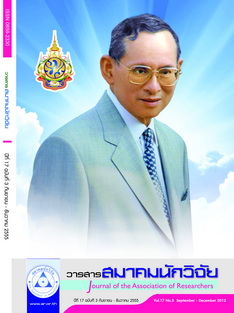PREDICTING FACTORS OF BODY IMAGE SATISFACTION OF STUDENTS IN BANGKOK
Main Article Content
Abstract
The purpose of this work is to investigate factors that can predict body image the satisfaction of undergraduate students in the Bangkok area. The underlying factors include gender, television watching and magazine reading, susceptibility to peer influence, and imitation of media celebrities. In this survey research, the questionnaires were used to collect data from 620 students. The study reveals that the students were moderately satisfied with their body image. Additionally, Multiple Regression analysis indicates that the three factors, namely the number of hours in watching television, susceptibility to peer influence, and imitation of media celebrities had a negative influence on body image satisfaction while gender and number of hours in reading magazines did not affect their body image satisfaction.
Article Details
บทความที่ปรากฏในวารสารนี้ เป็นความรับผิดชอบของผู้เขียน ซึ่งสมาคมนักวิจัยไม่จำเป็นต้องเห็นด้วยเสมอไป การนำเสนอผลงานวิจัยและบทความในวารสารนี้ไปเผยแพร่สามารถกระทำได้ โดยระบุแหล่งอ้างอิงจาก "วารสารสมาคมนักวิจัย"
References
สํานักงานคณะกรรมการการอุดมศึกษา. (2553). ข้อมูลสารสนเทศทางการศึกษา กระทรวงศึกษาธิการ. ค้นเมื่อ 15 ตุลาคม 2553, จาก http://www.moe.go.th/data stat/
สุชาติ ประสิท (2537), เทคนิคการวิเคราะห์ตัวแปรหลายตัวสําหรับการวิจัยทางสังคมศาสตร์และ พฤติกรรมศาสตร์: หลักการ วิธีการ และการประยุกต์, กรุงเทพมหานคร: สถาบันบัณฑิตพัฒนบริหารศาสตร์,
Avalos, L., Tylka, T. L., & Wood-Barcalow, N. (2005). The body satisfaction scale: Development and psychometric evaluation. Body image, 2, 285-297.
Calado, M., Lameiras, M., Sepulveda, A. R., Rodriguez, Y., & Carrera, M. V. (2011). The association between exposure to mass media and body dissatisfaction among Spanish adolescents. Women's Health Issues, In Press, Corrected Proof. DOI: 10.1016/j.whi.2011.02.013
Cash, T. F., & Brown, T. A. (1989). Gender and body images: Stereotypes and realities. Sex Roles, 21(5), 361-373. doi: 10.1007/bf00289597
Cooper, D. R., & Sclindler, P. S. (2001). Business Research Methods (7th ed.). Singapore: McGraw-Hill.
Chulanee Thianthai (2008). Influential sources affecting Bangkok adolescent body image perceptions. International Journal of Adolescent Medicine and Health, 18(4), 633-643. Jones, D.-C. (2004). Body image among adolescent girls and boys: A longitudinal study. Developmental Psychology, 40(5), 823-835.
Jones, D. C., Vigfusdottir, T. H. & Lee, Y. (2004). Body image and the appearance culture among adolescent girls and boys: An examination of friend conversations, peer criticism, appearance magazines, and internalization of appearance ideals. Journal of Adolescent Research, 19, 323-329.
Jones, D. C., & Crawford, J. K. (2005). Adolescent boys and body image: Weight and muscularity concerns as dual pathways to body dissatisfaction. Journal of Youth and Adolescence, 34,629-636.
Jung, J., & Forbes, G. B. (2007). Body dissatisfaction and disordered eating among college women in China, South Korea, and the United States: Contrasting predictions from sociocultural and feminist theories. Psychology of Women Quarterly, 31, 381-393.
Kasser, T., Ryan, R. M., Couchman, C.E. & Sheldon, K.M. (2004). Materialistic values: Their causes and consequences. In T. Kasser & A.D. Kanner (Eds.), Psychology and Consumer Culture. Washington, D.C.: American Psychology Association.
Littleton, H. L., & Ollendick, T. (2003). Negative body image and disordered eating behavior in children and adolescents: what places youth at risk and how can these problems be prevented? Clinical Child and Family Psychology Review, 6, 51-66.
Maltby, J., Giles, D. C., Barber, L., & McCutcheon, L. E. (2005). Intense-personal celebrity worship and body image: Evidence of a link among female adolescents. British Journal of Health Psychology, 10(1), 17-32. doi: 10.1348/135910704x15257
Mangleburg, T. F. & Bristol, T. (1998). Socialization and adolescents’ skepticism toward advertising. Journal of Advertising, 27(3), 11-21.
Mellor, D., McCabe, M., Ricciardelli, L., Yeow, J., Daliza, N., & Hapidzal, N. F. (2009). Sociocultural influences on body dissatisfaction and body change behaviors among Malaysian adolescents. Body Image, 6(2), 121-128. doi:10.1016/j.bodyim.2008.11.003
Murray, K. M., Byrne, D. G., & Rieger, E. (2011). Investigating adolescent stress and body image. Journal of Adolescence, 34(2), 269-278. doi: 10.1016/j.adolescence.2010.05.004
Pruzinsky, T., & Cash, T. F. (1990). Integrative themes in body-image development, deviance, and change. In T. G. Cash, & T. Pruzinsky (Eds.), Body images: Development, deviance, and change (pp. 338-349). New York: The Guilford Press.
Ricciardelli, L. A., & McCabe, M. P. (2003). A longitudinal analysis of the role of biopsychosocial factors in predicting body change strategies among adolescent boys. Sex Roles, 48(7), 349 359. doi: 10.1023/a:1022942614727
Shin, M., & Kubo, C. (2002). Body shape preference and body satisfaction in Taiwanese college students. Psychiatry Research, 111, 215-228.


